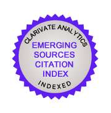Artes Visuales y Globalización: percepciones de profesores de arte y estudiantes de posgrado en una universidad saudí
DOI:
https://doi.org/10.22530/ayc.2023.23.637Palabras clave:
artes visuales, globalización, arte global, artistas visuales, arte contemporáneoResumen
Este estudio explora las percepciones de los profesores y estudiantes de arte sobre la relación entre el arte visual contemporáneo y la globalización, intentando ampliar el camino para la colaboración artística en todo el mundo. Se creó y administró un cuestionario abierto de globalización y artes visuales de veintiún ítems a una muestra de cuarenta y dos participantes, incluidos profesores y estudiantes de posgrado en la Facultad de Diseño y Arte de la Universidad Umm Al-Qura, Arabia Saudita. La encuesta se realizó con el uso de la herramienta 'SurveyMonkey'. Los datos recopilados se dividieron en varios temas mediante el uso de análisis cualitativo deductivo. Este análisis temático aclaró aún más el papel de la globalización en la configuración de las artes visuales y el desarrollo personal de los artistas. También destacó la importancia de promover una sana colaboración artística, albergar galerías de arte internacionales y abordar los desafíos que enfrentan los museos locales para reunir grandes audiencias en ausencia de apoyo externo.
Citas
ALBROW, M. (1996). The Global Age: State and Society Beyond Modernity. Cambridge: Polity Press.
ART-FERVOUR. (2020, May 16). Co-creating Brilliance: Famous Artistic Collabo-rations. Retrieved March 2, 2022, from Art Fervour: https://www.artfervour.com/post/timeless-collaborations-a-look-at-memorable-duos-of-the-art-world
ARTWORK-ARCHIVE. (2022). How to Connect with Other Artists and Boost Your Art Business. Retrieved March 02, 2022, from Artwork Archive: https://www.artworkarchive.com/blog/how-to-connect-with-other-artists-and-boost-your-art-business
BARBOUR, K., RATANA, D., WAITITI, C., & WALKER, K. (2007). Researching collaborative artistic practice. Waikato Journal of Education, 13(1), 49-77.
BARI, I. (2005). Globalizarea Economiei (Globalization of the economy). Bucha-rest: Economică.
BIELBY, D. D., & HARRINGTON, C. L. (2002). Markets and Meanings: The Global Syndication of Television Programming. In D. Crane, N. Ka-washima, & K. Kawasaki (Eds.), Global Culture: Media, Arts, Policy, and Globalization (pp. 215–232). New York, NY: Routledge. doi:10.4324/9781315538792
BOZOVIC, N. (2017). The Creative Process. Retrieved March 21, 2022, from Agora Gallery: Famous Art Collaborations: Art collaborations simply cannot be a bad idea: https://www.agora-gallery.com/advice/blog/2017/04/27/famous-art-collaborations
BUBLITZ, M. G., RANK-CHRISTMAN, T., CIAN, L., CORTADA, X., MADZHAROV, A., PATRICK, V. M., . . . TOWNSEND, C. (2019). Collaborative Art: A Transformational Force within Communities. Journal of the Association for Consumer Research, 4(4), 313-331. doi:10.1086/705023
BURTON, C., & SCOTT, C. (2003). Museums: Challenges for the 21st Century. International Journal of Arts Management, 5(2), 56-68.
CĂLINICĂ, R. M., & IOAN, V. (2015). Approaches and Controversies of the Globalization: The Possible Effects of Globalization. In E. Lukács (Ed.), Proceedings of the International Conference “Risk in Contemporary Economy” XVIth Edition (23-24 April, 2015) (pp. 353-358). Galati: Faculty of Eco-nomics and Business Administration, University of Galati.
CARROLL, N. (2007). Art and Globalization: Then and Now. The Journal of Aesthetics and Art Criticism, 65(1), 131–143. doi:10.1111/j.1540-594X.2007.00244.x
CLINE, A. C. (2012). The Evolving Role of the Exhibition and its Impact on Art and Culture. Unpublished B.A. Thesis. Hartford, CT: Trinity College. Re-trieved March 2, 2022, from https://digitalrepository.trincoll.edu/theses/267
CUTCHER, A. (2014). Drawing on Experience: The Challenges that General-ist Teachers Face in Delivering Visual Arts Effectively in Primary School. Australian Art Education, 36(1), 65-83.
DALELA, S. (2017, February 24). Why Collaboration Is The Way to Grow As An Artist. Retrieved March 02, 2022, from Dextra: https://medium.com/ dextra/why-collaboration-is-the-way-to-grow-as-an-artist-58f17bc4e918
DEMARRAIS, E., & ROBB, J. (2013). Art makes society: An introductory visual essay. World Art, 3(1), 3-22. doi:10.1080/21500894.2013.782334
DIMOVA, D., & GILLEN, E. J. (2017). Globalization and Cultural Identity: The Perspective of Contemporary Art. In J. Habich (Ed.), The 16th Salzburg Trilogue, 20 August 2017 (pp. 60-71). Gütersloh: The Bertelsmann Stiftung.
DUNCUM, P. (2001). Theoretical Foundations for an Art Education of Global Culture and Principles for Classroom Practice. International Journal of Ed-ucation & the Arts, 2(3), 1-15.
ENGELHARDT, R. A. (2005). Introduction: The role of the arts in improving the quality of education. In E. Meleisea (Ed.), Educating for Creatitvity: Bringing the arts and culture into Asian education (pp. 1-3). Bangkok: Unit-ed Nations Educational, Scientific and Cultural Organization (UNESCO).
FRIEDMAN, T. L. (2007). The World is Flat: A brief history of the twenty-first century. New York: Picador.
GIDDENS, A. (1984). The Constitution of Society. Cambridge: Polity Press.
GUDE, O. (2004). Postmodern principles: In search of a 21st century art edu-cation. Art Education, 57(1), 6-14. doi:10.1080/00043125.2004.11653528
HAY, C., & MARSH, D. (2000). Introduction: Demystifying Globalization. In C. Hay, & D. Marsh (Eds.), Demystifying Globalization (pp. 1-17). Lon-don: Macmillan Press Ltd.
HOBBS, R. C. (1984). Rewriting History: Artistic collaboration since 1960. In C. J. McCabe (Ed.), Artistic collaboration in the twentieth century (pp. 63-87). Washington, D.C: Smithsonian Institution Press.
HOLMES, A. M. (2016). Case study: 'Emergence' exhibition - regional artists and scientists in collaboration. In C. Perkins (Ed.), RUN Regional Futures Conference, 21-24 June 2016 (pp. 1-4). Rockhampton: Central Queensland University.
KAPLINSKY, R. (2005). Globalization, Poverty, and Inequality. Cambridge: Poli-ty Press.
KAUFMANN, T. D., DOSSIN, C., & JOYEUX-PRUNEL, B. (2016). Introduction: Reintroducing Circulations: Historiography and the Project of Global Art History. In T. D. Kaufmann, C. Dossin, & B. Joyeux-Prunel (Eds.), Circu-lations in the Global History of Art (pp. 1-22). New York: Routledge. doi:10.4324/9781315572062
KOFMAN, E., & YOUNGS, G. (1996). Introduction: Globalization – The Second Wave. In E. Kofman, & G. Youngs (Eds.), Globalization: Theory and Prac-tice (pp. 1-8). London: Pinter.
LACHAPELLE, R., MURRAY, D., & NEIM, S. (2003). Aesthetic Understanding as Informed Experience: The Role of Knowledge in Our Art Viewing Ex-periences. Journal of Aesthetic Education, 37(3), 78–98. doi:10.2307/3527305
LARSSON, N. (2018, October 30). How to make a living from your art: Young artists share their stories. The Guardian. Retrieved March 04, 2022, from https://www.theguardian.com/education/2018/oct/30/how-to-make-a-living-from-your-art-young-artists-share-their-stories
MARTELL, L. (2007). The Third Wave in Globalization Theory. International Studies Review, 9(2), 173–196.
MCCHESNEY, R. W. (1999, Nov.,11). The New Global Media. The Nation. Retrieved February 10, 2022, https://www.thenation.com/article/archive/new-global-media/
MCGREW, A. G. (1992). Conceptualizing Global Politics. In A. G. McGrew, & P. G. Lewis (Eds.), Global Politics: Globalization and the Nation States (pp. 1-7). New York: Wiley.
NAKAMURA, K. (2009). The Significance of Dewey's Aesthetics in Art Edu-cation in The Age of Globalization. Educational Theory, 59(4), 427-440. doi:10.1111/j.1741-5446.2009.00329.x
OHMAE, K. (1990). Borderless World. London: HarperCollins Publishers.
PIETERSE, J. N. (2009). Globalization and Culture: Global Mélange. Lanham, MD: Rowman & Littlefield.
POPESCU, I. A., BONDREA, A. A., & CONSTANTINESCU, M. I. (2004). Globaliza-rea: Mit si realitate (Globalization: Myth and reality). Bucharest: Economică.
PUPPE, L., JOSSBERGER, H., STEIN, I., & GRUBER, H. (2020). Professional De-velopment in Visual Arts. Vocations and Learning, 13(1), 389–417. doi:10.1007/s12186-020-09246-0
REDINS, L. (2014, May 09). Why are Art Galleries Important? Retrieved Feb-ruary 12, 2022, from Mehta Art Gallery: http://www.mehtaartgallery.org/why-are-art-galleries-important
REICH, R. B. (1991). The Work of Nations: Preparing Ourselves for 21st Century Capitalism. New York: Knopf Publishing.
RITZER, G., & STILLMAN, T. (2003). Assessing McDonaldization, Americani-zation and Globalization. In U. Beck, N. Sznaider, & R. Winter (Eds.), Global America? The Cultural Consequences of Globalization (pp. 30-48). Liverpool: Liverpool University Press.
ROBERTS, T. L. (2009). Collaboration in Contemporary Artmaking: Practice and Pedagogy. Unpublished Doctoral Dissertation. Columbus: The Ohio State University.
RODRIGUEZ, F., & SHERMAN, A. (1983). Cultural Pluralism and the Arts: A Multicultural Perspective for Teacher Trainers in Art and Music. Lawrence, KS: University Press of Kansas.
SHERMAN, D. J., & ROGOFF, I. (1994). Introduction: Frameworks for Critical Analysis. In D. J. Sherman, & I. Rogoff (Eds.), Museum Culture: Histories, Discourses, Spectacles (pp. ix-xx). Minneapolis: University of Minnesota.
SHERWIN, B. (2013, January 27). Artist as Storyteller: Be tactful when sharing your story. Retrieved February 17, 2022, from Fine Art Views: https://fineartviews.com/blog/55303/artist-as-storyteller-be-tactful-when-sharing-your-story-part-1
SKLAIR, L. (2002). Globalization: Capitalism and its Alternatives. Oxford: Ox-ford University Press.
THOMPSON, J. B. (1995). The Media and Modernity: A Social Theory of the Me-dia. Stanford, CA: Stanford University Press.
THOMPSON, K. (2015). The Transformationalist View of Globalization. Retrieved November 15, 2022, from ReviseSociology: https://revisesociology.com/2015/09/24/transformationalist-globalization
TOMLINSON, J. (1999). Globalization and Culture. Cambridge: Polity Press.
VELTHUIS, O. (2015). Globalization of the Art Market [Emerging Art Mar-kets]. Grove Art Online, 1(1), 1-7. doi:10.1093/gao/9781884446054.article.T2274637
WADE, R., & WOLF, M. (2003). Are Global Poverty and Inequality Getting Worse? In D. Held , & A. McGrew (Eds.), The Global Transformations Reader: An Introduction to the Globalization Debate (2nd ed., pp. 440-447). Cambridge: Polity Press.
WALKUP, N. (2013, September 23). The Benefits of Attending Art Education Conferences. Retrieved February 17, 2022, from Davis Art: https://www.davisart.com/blogs/schoolarts-room/the-benefits-of-attending-art-education
WELCH, G. W., HAWLEY, L. R., & MCCORMICK, C. (2013). Bridging the Gap: Expanding Access to the Visual Arts through Distance Technology. Benton-ville, AR: Crystal Bridges Museum of American Art.
YOUNG, L. (1999). Globalisation, Culture and Museums: A Review of Theo-ry. International Journal of Heritage Studies, 5(1), 6-15. doi:10.1080/135272599087222
Descargas
Publicado
Cómo citar
Número
Sección
Licencia
Derechos de autor 2023 ARTE Y CIUDAD. Revista de Investigación

Esta obra está bajo una licencia internacional Creative Commons Atribución-NoComercial 4.0.











